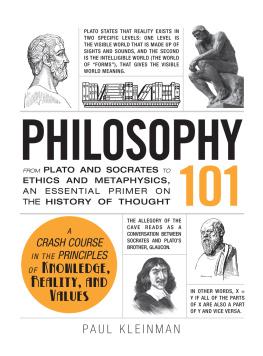Contents
Guide

Adams Media
An Imprint of Simon & Schuster, Inc.
57 Littlefield Street
Avon, Massachusetts 02322
www.SimonandSchuster.com
Copyright 2019 by Simon & Schuster, Inc.
All rights reserved, including the right to reproduce this book or portions thereof in any form whatsoever. For information address Adams Media Subsidiary Rights Department, 1230 Avenue of the Americas, New York, NY 10020.
First Adams Media trade paperback edition December 2019
ADAMS MEDIA and colophon are trademarks of Simon & Schuster.
For information about special discounts for bulk purchases, please contact Simon & Schuster Special Sales at 1-866-506-1949 or .
The Simon & Schuster Speakers Bureau can bring authors to your live event. For more information or to book an event, contact the Simon & Schuster Speakers Bureau at 1-866-248-3049 or visit our website at www.simonspeakers.com.
Interior design by Colleen Cunningham
Interior images by Ivan Ryabokon; 123RF/abscent
Cover design by Sylvia McArdle
Cover image 123RF/abscent
Library of Congress Cataloging-in-Publication Data
Names: Kleinman, Paul, author.
Title: All the sh*t you should have learned / Paul Kleinman.
Description: Avon, Massachusetts: Adams Media, 2019.
Identifiers: LCCN 2019037995 | ISBN 9781507212400 (pb) | ISBN 9781507212417 (ebook)
Subjects: LCSH: Curiosities and wonders. | History--Miscellanea. | Literature--Miscellanea. | Mathematics--Miscellanea. | Science--Miscellanea.
Classification: LCC AG244 .K54 2019 | DDC 031.02--dc23
LC record available at https://lccn.loc.gov/2019037995
ISBN 978-1-5072-1240-0
ISBN 978-1-5072-1241-7 (ebook)
Many of the designations used by manufacturers and sellers to distinguish their products are claimed as trademarks. Where those designations appear in this book and Simon & Schuster, Inc., was aware of a trademark claim, the designations have been printed with initial capital letters.
Contains material adapted from the following title published by Adams Media, an Imprint of Simon & Schuster, Inc.: A Ton of Crap by Paul Kleinman, copyright 2011, ISBN 978-1-4405-2935-1.
INTRODUCTION
When did the Ming Dynasty rule?
What is the Pythagorean Theorem used to calculate?
How many layers does the Earth have?
At some point, you probably knew the answer to at least one of these questions. Sure, you may have no idea what the answer is right now, but thats not your fault. Youve got a lot going on, and All the Sh*t You Should Have Learned understands that. What follows is a digestible re-education in everything you probably learned at one time or another, but forgot because your head is filled with so much other crap; crap like the dates of every family members birthday (your second cousin included), the roads you should avoid during rush hour, and the ingredients for your favorite meat sauce recipe.
In the following pages, youll be schooled in five academic subjects: History, Language, Math, Science, and Foreign Language. All the major players from your school days. But instead of getting one long lecture that makes your head pound, each subject is broken down into smaller topics, like Ancient Egypt, Logarithms, the Solar System, French, and Poetry. These nuggets of information avoid a brain dump of information, and help you retain all the wisdom youve accumulated instead of flushing it down the toilet.
So get comfortable, relax, and get ready to learn (or relearn) all the sh*t you should really already know.

MESOPOTAMIA AND THE FIRST CIVILIZATIONS
THE SUMERIANS Six thousand years ago, the first civilizations developed between the Tigris and Euphrates Rivers in what is now Iraq. The first civilization was known as Sumer, and the different villages developed self-governing city-states with a pyramidal temple, or ziggurat, at the center of each city-state. As a result of the location, there was seasonal flooding and a hot, dry environment. This led to very fertile ground, which farmers took advantage of, producing crops such as wheat, barley, sesame, and flax.
ZIGGURATS The ziggurats at the heart of each city-state served many purposes. Not only were they there for religious reasons, but they were also the center of daily life for the Sumerian people. The Sumerians believed there were many powerful gods in the sky, and they dedicated these large temples to them with steps leading to the top. The ziggurats were built of mud brick. At the very top of each, religious ceremonies were held.
THE AKKADIANS The Akkadians were a Semitic people from the Arabian Peninsula who increasingly came into conflict with the Sumerians as they migrated north. In 2340 B.C ., Sargon, the Akkadian military leader, conquered Sumerian city-states and established an Akkadian empire over the land. Sargon established his rule in the city of Akkad, and created the largest empire known to humankind at that time. The empire was short lived, and in 2150 B.C ., the Akkadian Empire fell.
BABYLONIA As the last Sumerian dynasty fell, the Amorites came to power, basing their capital in Babylon. One of the most notable legal texts in history comes from this time period, when the king, Hammurabi, created one of the first sets of written laws. This is called the Code of Hammurabi. These laws were written out so that all would know the punishments if they disobeyed them. One of the most famous paraphrases of this code is An eye for an eye, and a tooth for a tooth.
THE HITTITES No one knows the origins of the Hittites, and until recently, their language was undecipherable (it was in the Indo-European family). Their invasion brought the end of the Old Babylonian Empire; however, as they conquered Mesopotamia, they adopted the laws, literature, and religion of Old Babylon. The Hittites are most notable for their work involved in trade and commerce, which spread Mesopotamian literature and thought all over the Mediterranean.
INVENTIONS Many important inventions came out of Mesopotamia. The seed plow was revolutionary in agriculture, and allowed seeding and plowing to occur simultaneously. The people of Mesopotamia also created a writing system based on images called cuneiform, developed irrigation and sanitation methods, created glass, and around 3500 B.C ., invented the wheel. They were also the first to harness wind energy by creating sails.

XIA DYNASTY
REAL OR LEGEND? The Xia Dynasty, said to be the first imperial dynasty of China, is supposed to have lasted from the twenty-first to the seventeenth century B.C . with seventeen emperors. It is still up for debate whether the Xia Dynasty actually existed or whether it is merely a legend told in the ancient texts.
















